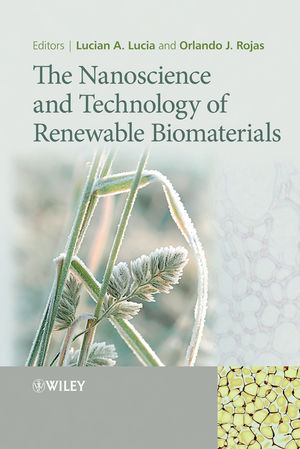The Nanoscience and Technology of Renewable BiomaterialsISBN: 978-1-4051-6786-4
Hardcover
366 pages
November 2009, Wiley-Blackwell
 |
||||||
Theodore H. Wegner and E. Philip Jones
1.1 Introduction
1.2 Use of Lignocellulosic-based Materials
1.3 Green Chemistry and Green Engineering
1.4 Nanotechnology
1.5 Nanotechnology-enabled Product Possibilities
1.6 Wood Nanodimensional Structure and Composition
1.7 Nanomanufacturing
1.8 Nanotechnology Health and Safety Issues
1.9 Instrumentation, Metrology, and Standards for Nanotechnology
1.10 A Nanotechnology Agenda for the Forest Products Industry
1.11 Forest Products Industry Technology Priorities
1.12 Nanotechnology Priority Areas to Meet the Needs of the Forest Products Industry
1.13 Summary
References
2 Biogenesis of Cellulose Nanofibrils by a Biological Nanomachine
Candace H. Haigler and Alison W. Roberts
2.1 Introduction
2.2 Background
2.3 CesA Protein is a Major Component of the Plant CSC
2.4 The Functional Operation of the CSC
2.5 Phylogenetic Analysis
2.5.1 Possible Functional Diversification of CS Proteins
2.6 Conclusion
References
3 Tools for the Characterization of Biomass at the Nanometer Scale
James F. Beecher, Christopher G. Hunt and J.Y. Zhu
3.1 Introduction
3.2 Water in Biomass
3.3 Measurement of Specific Biomass Properties
3.4 Microscopy and Spectroscopy
3.5 Summary
References
4 Tools to Probe Nanoscale Surface Phenomena in Cellulose Thin Films: Applications in the Area of Adsorption and Friction
Junlong Song, Yan Li, Juan P. Hinestroza and Orlando J. Rojas
4.1 Introduction
4.2 Polyampholytes Applications in Fiber Modification
4.3 Cellulose Thin Films
4.4 Friction Phenomena in Cellulose Systems
4.5 Lubrication
4.6 Boundary Layer Lubrication
4.7 Techniques to Study Adsorption and Friction Phenomena
4.8 Surface Plasmon Resonance (SPR)
4.9 Quartz Crystal Microbalance with Dissipation (QCM)
4.10 Application of SPR and QCM to Probe Adsorbed Films
4.11 Lateral Force Microscopy
4.12 Summary
Acknowledgements
References
5 Polyelectrolyte Multilayers for Fibre Engineering
Rikard Lingström, Erik Johansson and Lars Wågberg
5.1 Background
5.2 The Formation of PEM on Wood Fibres
5.3 Formation of PEM with Different Polyelectrolytes and the Properties of the Layers Formed
5.4 Formation of PEM on Fibres
5.5 Influence of PEM on Properties of Fibre Networks
5.6 Influence of PEM on Adhesion Between Surfaces
5.7 Concluding Remarks
Acknowledgements
References
6 Hemicelluloses at Interfaces: Some Aspects of the Interactions
Tekla Tammelin, Arja Paananen and Monika Österberg
6.1 Overview
6.2 Introduction
6.3 Theoretical Basis for Interpreting QCM-D and AFM Data
6.4 Experimental
6.5 Results
6.6 Discussion
6.7 Conclusions
Acknowledgements
References
7 Lignin: Functional Biomaterial with Potential in Surface Chemistry and Nanoscience
Shannon M. Notley and Magnus Norgren
7.1 Introduction
7.2 Lignin Synthesis and Structural Aspects
7.3 Isolation of Lignin from Wood, Pulp and Pulping Liquors
7.4 Solution Properties of Kraft Lignin
7.5 Surface Chemistry of Solid State Lignin
7.6 Lignin: Current and Future Uses
7.7 Concluding Remarks
References
8 Cellulose and Chitin as Nanoscopic Biomaterials
Jacob D. Goodrich, Deepanjan Bhattacharya and William T. Winter
8.1 Overview
8.2 Introduction
8.3 Preparation and Microscopic Characterization of Cellulose and Chitin Nanoparticles
8.4 NMR Characterization of Cellulose and Chitin Nanoparticles
8.5 Chemical Modification of Cellulose and Chitin Nanoparticles
8.6 Nanocomposite Properties
8.7 Conclusions
Acknowledgements
References
9 Bacterial Cellulose and its Polymeric Nanocomposites
Marie-Pierre G. Laborie
9.1 Introduction
9.2 Bacterial Cellulose: Biosynthesis and Basic Physical and Mechanical Properties
9.3 BC Nanocomposites by in situ Polymerization
9.4 BC Nanocomposites by Polymer Impregnation and Solution Casting
9.5 BC Nanocomposites via Biomimetic Approaches
9.6 BC/Polymer Nanocomposites Based on Bacterial Cellulose Nanocrystals
9.7 Conclusions and Prospects
References
10 Cellulose Nanocrystals in Polymer Matrices
John Simonsen and Youssef Habibi
10.1 Introduction
10.2 Background on CNXL Material Science
10.3 Polymer Nanocomposite Systems
10.4 Thermal Properties
10.5 Mechanical Properties of CNXL
10.6 Transport Properties
References
11 Development and Application of Naturally Renewable Scaffold Materials for Bone Tissue Engineering
Seth D. McCullen, Ariel D. Hanson, Lucian A. Lucia and Elizabeth G. Loboa
11.1 Introduction
11.2 Natural Renewable Materials for Bone Tissue Engineering
11.3 Bone Background
11.4 Conclusions and Future Directions
References
12 Template Synthesis of Nanostructured Metals Using Cellulose Nanocrystal
Yongsoon Shin and Gregory J. Exarhos
12.1 Overview
12.2 Introduction
12.3 Metal Oxide and Metal Carbides
12.4 Metal Nanoparticles on CNXL
12.5 Conclusion
Acknowledgements
References



